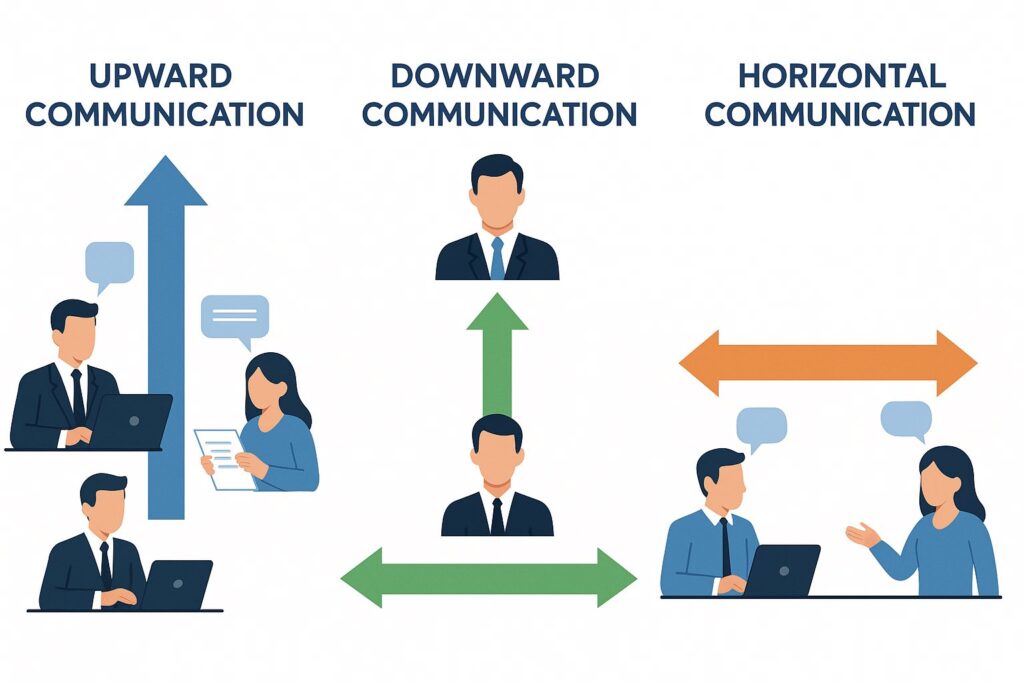In any workplace, communication works like the nervous system of a body. It carries ideas, instructions, and feedback that keep everything alive and moving. Without the right flow of information, even the smartest team may struggle. That is why organizations rely on three key communication directions: upward, downward, and horizontal.
Each of these flows plays a unique role. They shape how leaders and employees share thoughts, how policies are spread, and how teams collaborate. In this article, we will compare upward vs downward vs horizontal communication and highlight their key differences. By the end, you will see why mastering all three flows is essential for a healthy workplace.
What is Upward Communication?
Upward communication is the process where information moves from employees to their supervisors or top management. Think of it as the voice of the team reaching the ears of leaders.
Employees usually share feedback, reports, suggestions, or even concerns. For example, when a teacher tells the principal that new classroom equipment is not working well, that is upward communication. Another example could be an employee survey where workers share their opinions about company culture.
This type of communication is powerful because it gives management a clear idea of what is happening on the ground. If you want a deeper dive into examples and benefits, you can check our dedicated post on Upward Communication Examples and Benefits.
What is Downward Communication?
Now, let us flip the direction. Downward communication happens when information flows from managers or supervisors to employees. It often includes instructions, policies, announcements, or even performance reviews.
Imagine the CEO of a company sending out a memo about a new dress code. That is a perfect example of downward communication. Similarly, when a teacher receives a guideline from the school board, it is also a downward flow.
This method works best when organizations need clarity and control. However, if it is overused without listening to feedback, it can sometimes feel one-sided.
What is Horizontal Communication?
Unlike upward or downward flows, horizontal communication works between peers who are at the same level in the hierarchy. It is often used to coordinate, collaborate, or solve problems together.
For instance, two marketing managers discussing an upcoming campaign use horizontal communication. Another example would be doctors in the same hospital department sharing patient updates.
Horizontal communication encourages teamwork and reduces misunderstandings between departments. It keeps projects moving smoothly because everyone is on the same page.
Key Differences: Upward vs Downward vs Horizontal Communication
Now comes the heart of the discussion. Let us break down the differences in a simple comparison.
| Aspect | Upward Communication | Downward Communication | Horizontal Communication |
|---|---|---|---|
| Direction of Flow | Employee to management | Management to employee | Peer to peer |
| Purpose | Feedback, reporting, suggestions | Instructions, policies, guidelines | Coordination and teamwork |
| Examples | Employee surveys, progress reports, complaints | Memos, performance reviews, official announcements | Team meetings, peer discussions, emails between colleagues |
| Advantages | Builds trust, promotes innovation, improves engagement | Provides clarity, ensures consistency, maintains order | Encourages collaboration, reduces conflict, increases efficiency |
| Challenges | Fear of speaking up, hierarchical barriers | Risk of being too controlling, information overload | Misalignment, lack of authority to implement changes |
This table highlights the central differences. When people search for “upward vs downward communication,” this comparison gives them a clear answer while also adding the role of horizontal communication for a complete picture.

When to Use Each Communication Flow
Each type of communication has its best time and place.
- Upward communication works best when employees need to report progress, share challenges, or give feedback. For example, sending weekly performance updates to management.
- Downward communication is most useful when leaders want to roll out a new policy or share strategic goals. For example, announcing new working hours.
- Horizontal communication shines when peers need to collaborate, like when two departments coordinate to launch a new product.
Rather than choosing one over the others, organizations should understand when to use each flow.
Benefits of Balancing All Three Types
A workplace cannot survive on only one direction of communication. Balancing upward, downward, and horizontal flows ensures that everyone’s voice is heard, leaders can set clear goals, and teams can coordinate without confusion.
Above all, this balance strengthens decision-making. Leaders get real feedback from upward communication, they share policies through downward communication, and peers solve problems together using horizontal communication. The result is better employee engagement and stronger organizational alignment.
Challenges in Managing Multiple Communication Flows
Of course, no communication style is perfect. Each one comes with challenges.
- Upward communication can suffer if employees feel afraid to speak up. Hierarchical barriers may stop them from being honest.
- Downward communication may feel too controlling if leaders send out too many instructions without listening. Employees might feel overwhelmed.
- Horizontal communication can sometimes lead to misalignment. Colleagues may agree among themselves but still lack the authority to make final decisions.
Despite these challenges, the solution lies in awareness. Encouraging openness, training leaders, and setting up clear communication channels can fix most of these problems.
Final Thoughts
Understanding the differences between upward, downward, and horizontal communication is like learning the grammar of workplace interaction. Each flow has a role to play. Upward communication gives employees a voice, downward communication keeps the system organized, and horizontal communication makes teamwork possible.
On the contrary, relying too much on one style can create gaps. That is why smart organizations focus on balancing all three. The healthier the balance, the stronger the workplace culture.
If you found this comparison interesting, you might want to check out our earlier piece on Upward Communication Examples and Benefits. It dives into how upward communication works in real life and outlines some of its perks!


